The recent spread of the COVID-19 pandemic has led to the postponement or cancellation of arts markets and festivals across the globe. Under these circumstances, everyone involved in the international performing arts market has become deeply concerned. Nevertheless, the pandemic will certainly reach its end someday and will be remembered as one of the challenges faced by humanity. It is in this context that we edit and provide what was discussed at the PAMS Salon (October 2019) under the theme of the “Transformation and Innovation in the Performing Arts Market,” looking forward to ongoing discussion on the theme.
- Editor’s Note
Date: Oct. 8th (Tue) 13:30~15:00
Venue: IEUM Art Hall at IEUM Center (5th floor)
Cooperation:
TPAM-Performing Arts Meeting in Yokohama
CINARS-Conférences internationale des arts de la scène
Australian Performing Arts Market (APAM)
Moderator: Kyu Choi (Producer, AsiaNow)
Speaker (in alphabetical order):
Gilles Dore (International Development Director, CINARS)
Hiromi Maruoka (Director, TPAM-Performing Arts Meeting in Yokohama)
Naomi Velaphi (Program Producer, Australian Performing Arts Market)
Shin-ah Kim (Director, Performing Arts Division of Korea Arts Management Service)
Rapid growth of highly specialized and segmented international networks and increased exposure of emerging companies through digital media encourage or even require changes in how the preforming arts market could work for a sustainable market and mobility development. In the context of today’s active discussions on the social roles of art for a more inclusive society stressing diversity, could or should the arts market respond to these discussions through its future transformation and innovation?
Moderator- Kyu Choi:
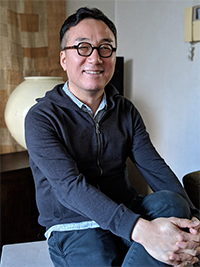 Arts markets started as platforms that facilitate the distribution of creative content for artists, companies, presenters, promoters and programmers. Performing arts markets appeared later than fairs of other genres such as cinema, music and fine art. The oldest market we know is France’s Mars, which was launched in the 1980’s but soon disappeared. The next one was CINARS, the first presenter of today’s roundtable, which began in Montreal, Quebec, Canada. CINARS isn’t called a “market” anymore but it is still regarded as the eldest sibling of performing arts markets. Launched in 1984, CINAR has influenced Asian countries and Australia with its model.
Arts markets started as platforms that facilitate the distribution of creative content for artists, companies, presenters, promoters and programmers. Performing arts markets appeared later than fairs of other genres such as cinema, music and fine art. The oldest market we know is France’s Mars, which was launched in the 1980’s but soon disappeared. The next one was CINARS, the first presenter of today’s roundtable, which began in Montreal, Quebec, Canada. CINARS isn’t called a “market” anymore but it is still regarded as the eldest sibling of performing arts markets. Launched in 1984, CINAR has influenced Asian countries and Australia with its model.
Whether they are called an art platform, arts market or any other name, performing arts markets’ biggest goals have been the invigoration of content distribution and development of overseas markets. Afterward, as changes in the global performing arts scene have led to changes in arts markets, other goals have been added: international exchange, mobility development and information sharing. As latecomers, Asian countries have also used markets as a springboard for raising their national status and for introducing their arts scene to other countries. Recent markets tend to pursue information sharing and human networks rather than marketability. Indeed, TPAM has renamed itself the Performing Arts Meeting in Yokohama, instead of the Tokyo Performing Arts Market.
The international performing arts scene is changing rapidly, with more specialized and subdivided global networks coming forth in great numbers. Each country is facing different needs. Thanks to digital media, some of the young explore overseas performing arts markets through online platforms, without even visiting the site in person. Considering such changes in the environment, what kind of growth and changes would today’s performing arts markets need? In addition, as the social roles and values of art are stressed today, how would contemporary arts markets assimilate these themes and take responsibility?
1) Speaker- Gilles Dore (International Development Director, CINARS):
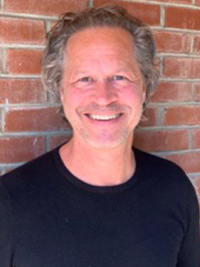 I have been with CINARS since June 2019. I have worked in the performing arts community for over 20 years and I was also a consortium member. I have accumulated rich experience by visiting many places with Alain Paré, founder of CINARS. In fact, CINARS doesn’t call itself a “market” anymore. That is because we are not a business selling something but a place of networking which transcends national borders. So we prefer terms such as “platform” and “network” rather than “market.”
I have been with CINARS since June 2019. I have worked in the performing arts community for over 20 years and I was also a consortium member. I have accumulated rich experience by visiting many places with Alain Paré, founder of CINARS. In fact, CINARS doesn’t call itself a “market” anymore. That is because we are not a business selling something but a place of networking which transcends national borders. So we prefer terms such as “platform” and “network” rather than “market.”
International development would remind you of “conquering the world” but it isn’t true. You just go beyond your national borders to search for partners. It is about finding colleagues in equal positions who could talk about art with you. The scope of art is wide so you should consider horizontal relationships in addition to vertical ones.
Launched in 1984, CINARS is a biennale that takes place in November. One of its major goals is to “bring the world to Montreal.” On one hand, the CINARS Biennale invites participants from all around the world. On the other hand, we connect artists and their representatives. We would rather like to use the term “represetative” rather than ”agent“ which reminds us of a person selling something.
Of course, we want to promote Canada’s own culture and Canada itself but transcending borders also means calling others’ transcended borders to us. So we want to invite international performances to our platform. In other words, we become family for a week and share what we have. It is important for us to go global but it is also crucial to invite the world to our platform. During the biennale week, we meet with countries including the US and Asian countries to realize mutualism. The world is changing. Technology is developing. Influenced by technology, our behavior is also changing. Consequently, society is being subdivided, leading to greater diversity in the performing arts scene. It is necessary to communicate with each subdivided artistic field and with the audience.
Moreover, today’s young artists are gathering momentum and it will continue. We are willing to support such young artists. Of course, international collaboration is important. CINARS is currently seeking collaboration with a variety of conferences, platforms and residencies and have numerous international partnerships.
In the beginning, we focused on the US market to develop works. But as time went by, we came to realize that shows from Quebec, Canada are close to those from Europe, Asia and the world. Nowadays, programmers working on specific fields come to Montreal and they want to watch full-length performances rather than showcases. So we will present only full-length performances in the future. Live full-length shows will accelerate decision-making. We are also planning to choose new themes like new technology and live art as well as sensitive themes we haven’t chosen before.
What is the status of CINARS in Canada? It supports the international development of five genres: dance, theater, multidisciplinary performance, circus and music. It has run a platform for 35 years. We are not a government organization so CINARS is run independently. We are funded by the Canada Council for the Arts but our major partners are artists. Producers are also important, of course. Today, we also collaborate with presenters. About a year ago, we started supporting Canadian presenters go global. For this year’s PAMS, five presenters came with us from Quebec. They are experiencing the site in person to find out about which Korean shows are good and if they could plan tours.
Let me explain the services provided by CINARS. First of all, we dispatch a delegation of about ten artists to foreign countries, eight to ten times a year. We also help artists’ representatives meet experts from different countries. It is not just about making use of technology to share videos but about meeting people actually. This makes deeper and stronger relationships. We are also working on professional development. We organize international seminars. We will hold a seminar for experts in May, in Denmark. We also provide consulting services for young artists and representatives in Quebec. CINARS takes place every other year and the next biennale will be held in November 2020. About 50 countries have participated in CINARS and its delegation has carried out about 170 activities. About 2,000 participants and 435 programmers visit the biennale. We are planning to subdivide genres and increase the number of programmers working on specific fields. We are also running OFF CINARS shows. CINARS always keeps mutualism in mind.
What changes are we considering? Throughout the world, we see socioeconomic factors influence culture. Over the past decade, the budget of the arts and culture scene has decreased while young artists have emerged and programmers’ decisions have shown greater variability. We feel all of this. Furthermore, new voices are appearing. We should carefully listen to the voices we will hear in the future. We also need to consider ecological values. We advocate humanistic values. We would like to address ecological issues during the 2020 Biennale.
2) Speaker- Hiromi Maruoka (Director, TPAM-Performing Arts Meeting in Yokohama):
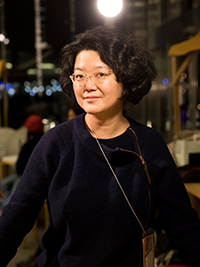 TPAM is a performing arts platform focused on contemporary performances. It was launched in 1997 as the Tokyo Performing Arts Market. Canada’s CINARS inspired us but a big difference between CINARS and TPAM is their cultural circumstances. North America and Japan both have a culture of theaters and performances but they are very different. To be more specific, Japanese audiences aren’t used to other countries’ performing arts so it has been difficult to bring international performances. The key point has been how to promote and sell international performances in Japan. One of our major purposes of founding TPAM was to sell Japanese works abroad. It was one-way communication. That was because the founder’s goal was to make a very large theater industry. We tried a great variety of models up to 2005. We also tried to build infrastructure but the number of international participants was very small.
TPAM is a performing arts platform focused on contemporary performances. It was launched in 1997 as the Tokyo Performing Arts Market. Canada’s CINARS inspired us but a big difference between CINARS and TPAM is their cultural circumstances. North America and Japan both have a culture of theaters and performances but they are very different. To be more specific, Japanese audiences aren’t used to other countries’ performing arts so it has been difficult to bring international performances. The key point has been how to promote and sell international performances in Japan. One of our major purposes of founding TPAM was to sell Japanese works abroad. It was one-way communication. That was because the founder’s goal was to make a very large theater industry. We tried a great variety of models up to 2005. We also tried to build infrastructure but the number of international participants was very small.
As I was appointed as the director of TPAM in 2005, we started turning to the contemporary performing arts. Major participants and presenters have been those who are very knowledgeable about international networks. Most of them have been producers. They regard art as part of public goods and services. So we came to form networks rather than buying and selling something. In other words, we renewed our motivation to reconsider why we should make an international platform. But we needed time. In 2007 and 2008, we had ITEM meetings in Seoul and Yokohama. At that time, Mr. Choi Seok-gyu was one of the major participants. Talking to the director and others, we asked ourselves why we needed to meet each other on platforms outside Asia. On that occasion, not only Japan and Korea but also everyone who wanted to build structural networks in Asia joined forces.
In 2011, TPAM moved from Tokyo to Yokohama. There wan’t any big reason for this. That was just because Tokyo’s major venue began to go through a construction project while Yokohama had a proper venue. It was at that time that we started using the name “meeting” instead of “market.” As we began to use the term “meeting,” we stopped showcases. Before that, TPAM had presented abstract showcases. The showcases were based on an open call so there were jurors who watched them. We replaced the showcases with the TPAM Direction Week.
In 2015, TPAM started focusing more on Asia. That was because participants coming all the way to Japan were interested in meeting not only Japanese experts and artists but also those from neighboring Asian countries. Except Singapore, many of Southeastern Asian countries didn’t have their own festivals. After TPAM launched its Asia Focus, it opened itself not only to Japanese artists but also to those from other Asian countries.
Since the launch of Asia Focus in 2015, almost 900 participants have visited TPAM annually. Half of them are Japanese and the other half is from other countries. Half of the international participants are Asian and the other half is European and North American.
TPAM presents its over 50 programs in numerous venues in Yokohama and Tokyo. These programs have diverse forms in order to meet different artists’ needs. The programs are divided into three categories. First, TPAM Exchange is composed of meetings. Second, TPAM Fringe offers programs based on an open call. Third, TPAM Direction has neither an open call nor a jury. Instead, curators are in charge of their own programming and they are asked to explain why they made such a choice. If you come to TPAM and watch a performance, your impression won’t be confined to whether you like it or not. Going beyond that, you will be able to feel the reason for presenting the performance at that moment. TPAM not only stages performances but it also works on co-production and outsourced production. Until last year, we co-produced eight performances. TPAM Exchange consists in meetings. The platform’s diverse meeting programs are led by participants. Everyone can participate after registration. The last one is TPAM Fringe. Recently, not only Japanese artists but also international ones have actively participated in it.
3) Speaker- Naomi Velaphi (Program Producer, Australian Performing Arts Market):
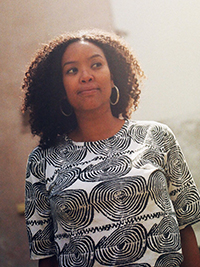 APAM is a strategic initiative led by the Australia Council for the Arts. It is currently run by Creative Victoria. APAM was founded to globally share the contemporary dance, theater, emerging art and experimental art of Australia and New Zealand. At first, we started in Canberra and gradually moved to Adelaide and Brisbane. From 2019 to 2024, APAM will take place in Melbourne. We decided to change APAM’s model to a single market after 2024. So we will work with a new team and format.
APAM is a strategic initiative led by the Australia Council for the Arts. It is currently run by Creative Victoria. APAM was founded to globally share the contemporary dance, theater, emerging art and experimental art of Australia and New Zealand. At first, we started in Canberra and gradually moved to Adelaide and Brisbane. From 2019 to 2024, APAM will take place in Melbourne. We decided to change APAM’s model to a single market after 2024. So we will work with a new team and format.
As APAM has been organized successfully for years, it has made contemporary contexts, connected contemporary Australian performing artists and linked works and their producers to presenters. We have a basic principle based on the mission given by the country: to gather experts together in one place so that they can meet each other in person. That is because we are well aware that face-to-face communication is effective in the arts scene. We will keep supporting artists and presenters to facilitate their closer relationships and we will also carry out numerous activities in artistic fields, through the year.
We have gone through so many changes so far. In particular, there have been many changes since the Australia Council for the Arts founded an arts organization in charge of domestic and international touring. So we are engaging in a great deal of international collaboration today. In addition, we are actively seeking opportunities to cooperate, including co-production. We are more and more interested in experimental, emerging and practice-based artists. We also dispatch presenters to meaningful and important festivals throughout the year. We keep communicating with artists through our platform and we also work on touring. Australia is still a large country with a small population, which makes touring difficult. Moreover, approaches to works and infrastructure differ from region to region. As for funding, we are running long-term programs with funds from several institutions.
Small and medium-sized companies and artists’ gatherings seek global opportunities. That is why APAM’s slogan is changing. In this way, we are adjusting to today’s changing topography. APAM now has a permanent secretariat and a Welcome Desk you can contact. We present works with experts gathered together. It is very effective to present a full-length performance in an actual theater setting with an audience. We also share information. In this regard, we take a very collaborative approach.
I will explain how it works actually. Our secretariat has a Welcome Desk which is run throughout the year. The desk is ready to welcome international visitors anytime. You can contact us in a variety of ways. For example, an Australian festival could collaborate with APAM’s office to organize an unofficial event helping local producers and artists meet each other.
We also check market information. We take a relationship-oriented approach, tracking data and checking outcomes. We manage our database by checking who visited us and why. We also share information to facilitate international participation even a little more. It is the first time for us to consistently track such data and to save it in a single space. We hope that such information leads us to come up with more resources and information in artistic fields. We will also organize a participatory event to see if there is any important information or insight to be shared by our colleagues who recently visited other markets or festivals. In this manner, our face-to-face meetings are also changing. All of this can be done simultaneously and promptly.
APAM will maintain its relationship-oriented approach by offering a wide variety of opportunities and by creating new opportunities. What is different from the past is the fact that we organize more events more frequently, in a greater number of places. APAM used to be held every other year year but from now on, it will take place twice a year. Depending on the period and schedule of cooperating festivals, the period of each APAM could be different. Its size could also be different according to circumstances. On the other hand, it will be a more meticulously targeted event. So far, APAM has attracted about 800 participants every other year. (After its change of frequency), APAM is expected to attract 200 to 400 participants for its first year. Some editions of APAM could be focused on specific genres or thematic contexts. Or, it could have a multi-arts form as in the case of the Darwin Festival. APAM could also have more side events. When it comes to the dates and periods of the events, they could change according to different settings like festivals in Avignon, Manchester and Edinburgh.
APAM could also include pitch sessions, introduction of facilitators, networking and evening showcase presentations that would be made available for participants. We could also plan our time and resources effectively, in advance. Meanwhile, curation came to change from a single mode to a multiple mode. Thanks to host festivals we cooperate with, APAM will also stage full-length performances. Starting with the Darwin Festival, we will go to Asia TOPA. We also have a program called “Profile.” The program consists in selection by an international panel. Performances are selected by the panel members who express their interest in three categories. We also offer pitch sessions. We are planning local partner events which will be curated by local players in the host city. Local partners will prepare events such as talks and network parties. We won’t install booths to be able to concentrate more on what we talk about. Australian artists will have an occasion to address more current issues. We also have professional programs designed for capacity building and strengthening.
We are willing to build meaningful relationships through a curation-based approach. We are ready to welcome you whenever you visit us. Our office is now open permanently and we are preparing for our 2020 gathering. We hope that this leads to more communication. For the next five years, we will make new attempts and meet new challenges. We look forward to joining these changes and to meeting more people.
Continue on the next article.
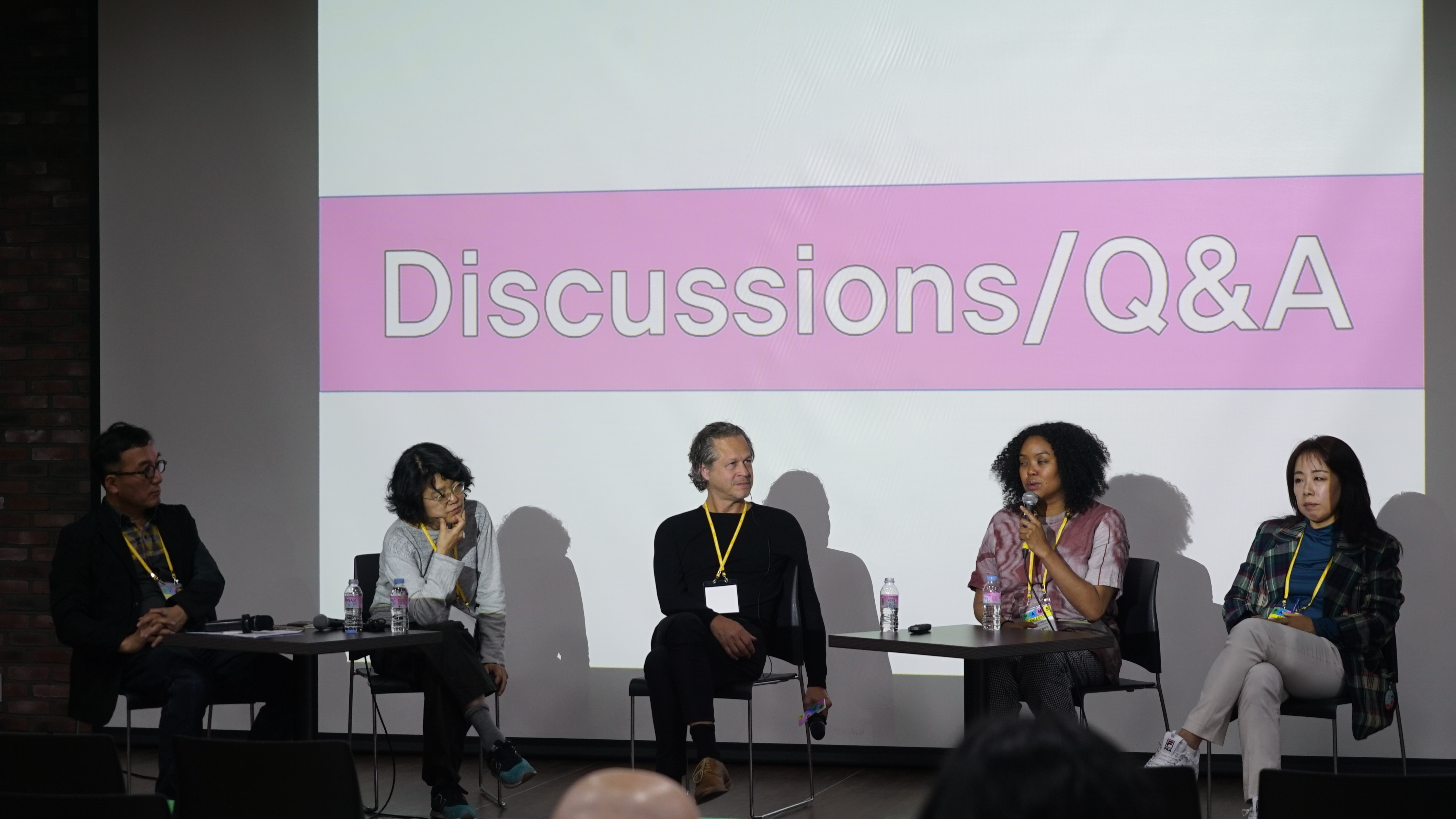
(From left) Kyu Choi (Moderator), Hiromi Maruoka(TPAM), Gilles Dore(CINARS),
Naomi Velaphi(APAM), Shin-ah Kim(KAMS) ⓒKAMS








 PREV
PREV
.jpg)
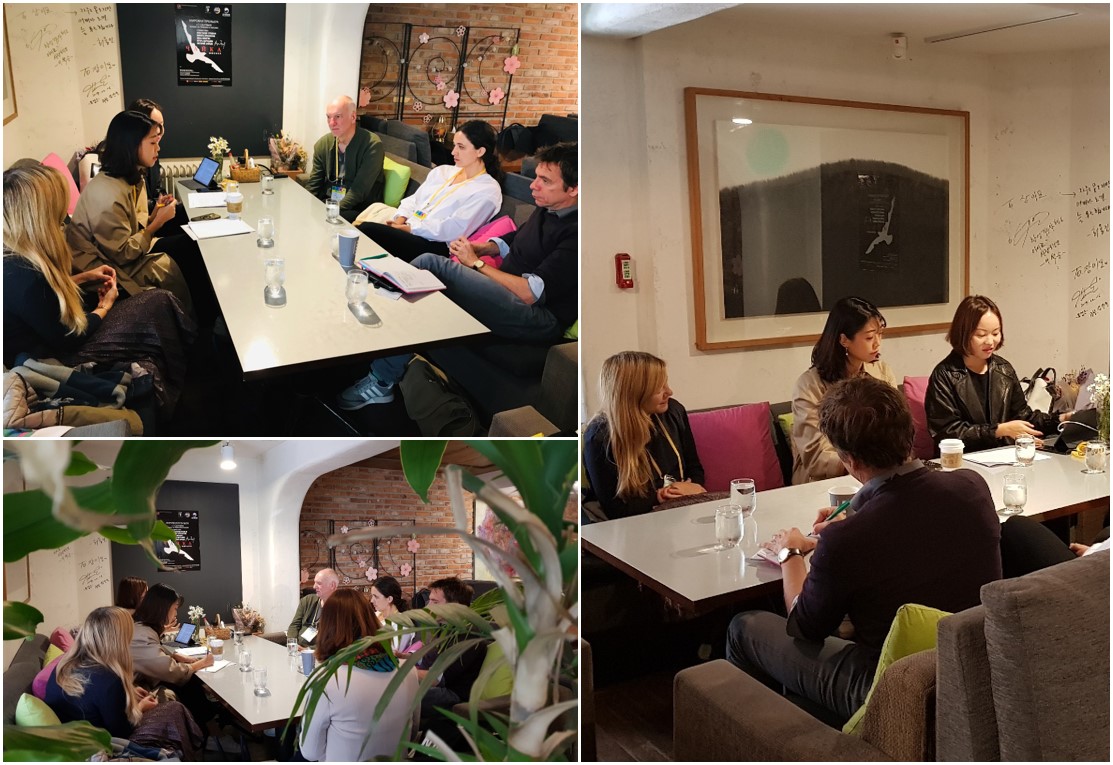
.jpg)
.jpg)
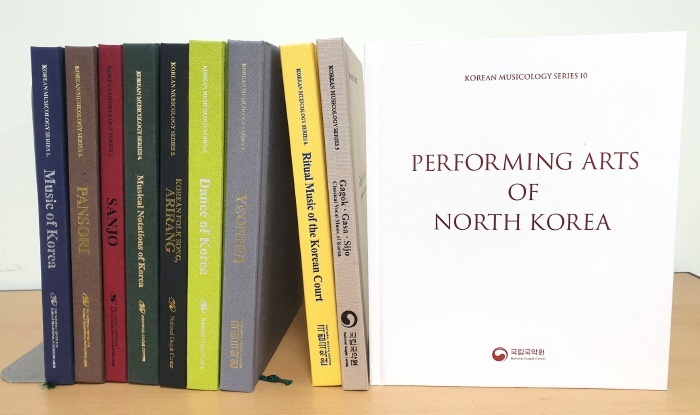
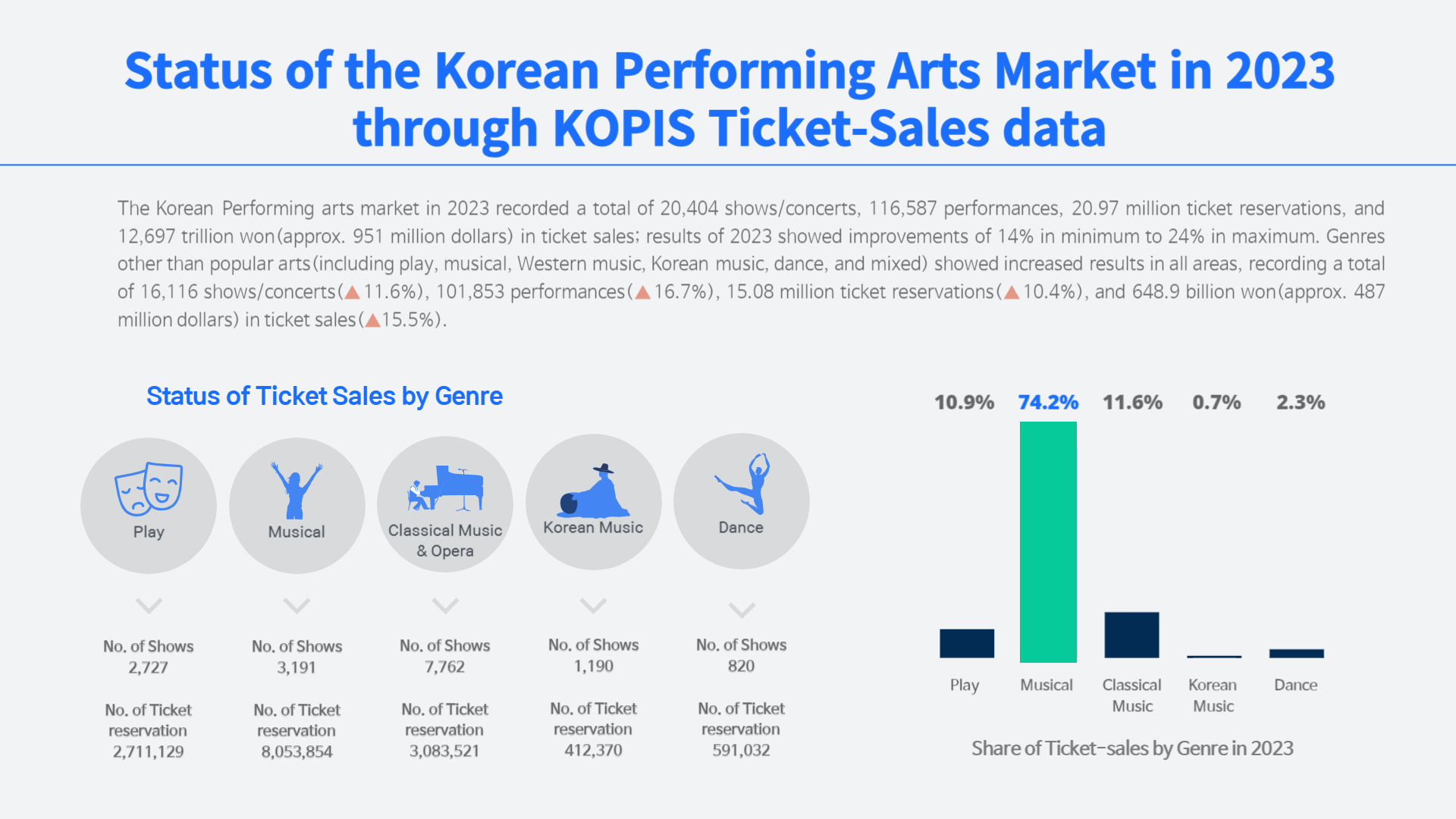
.jpg)
.jpg)
.jpg)
.jpg)











